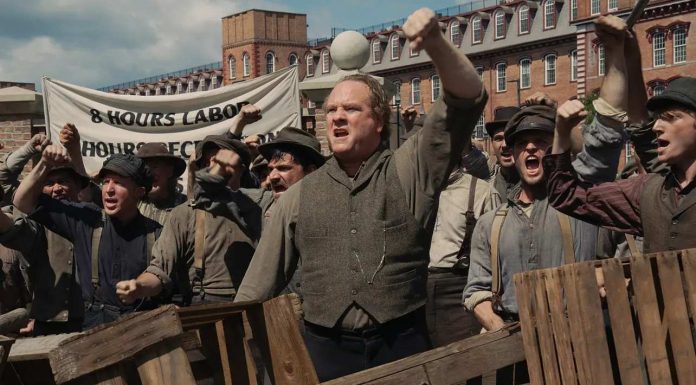The Gilded Age Season 2 Episode 6 is a compelling story as tensions in the workers’ strike spearheaded by Henderson, the union’s brave leader, reach a breaking point. In the struggle’s climax, Morgan Spector’s character George Russell makes a selfless choice that prevents possible violence but lays the groundwork for a more serious confrontation. Viewers are left on the edge of their seats as the series explores the dynamics of privilege, power, and the complexity of the time, waiting to see what happens after George’s selfless intervention. The Pittsburgh Steel Strike shown in The Gilded Age Season 2 raises a key question: Was it based on real events in history? tvacute explores the nuances that make this episode a gripping narrative, from the historical context to the character motives.
The Gilded Age Season 2 Episode 6: The Pittsburgh Steel Strike:
The Pittsburgh Steel Strike, a crucial point in the story, is brought to life for viewers in The Gilded Age Season 2‘s sixth episode. As the workers’ protest intensifies, Morgan Spector’s character George Russell finds himself in a precarious situation. As they attempt to stop scabs from crossing the picket line, Henderson, the union leader played by Darren Goldstein, confronts the real prospect of violence. This is when the tension reaches its pinnacle.
In a startling turn of circumstances, George steps in to avert what could have been disastrous. Despite being humanitarian, the choice causes friction with Patrick Page’s character, Richard Clay, his right-hand man. This confrontation, which is reminiscent of actual historical disputes between capitalists and their dependable supporters, paves the way for future confrontations. The program deftly balances political and personal themes, highlighting how the strike affected individuals like Peggy Scott and George Russell. The episode tackles important issues of power, morality, and the human cost of development as we examine the fallout from George’s selfless choice.
Is Pittsburgh Steel Strike a Real Strike?
The Pittsburgh Steel Strike serves as the focal point of one of the main narratives in “The Gilded Age” Season 2, which takes a risk by combining historical events. There is a strong similarity between the Homestead Strike of 1892 and the Pittsburgh Steel Strike that is portrayed in Season 2. This actual strike, which pitted laborers against wealthy industrialists in a struggle for their rights and dignity, was a turning point in the late 19th-century American labor movement. The conflict arose between the Carnegie Steel Company and the Amalgamated Association of Iron and Steel Workers (the AA) at the Homestead Steel Works in the Pennsylvanian town of Homestead, close to Pittsburgh.
In “The Gilded Age,” the story of the Russell family’s steel empire serves as the setting for a conflict akin to the Homestead Strike (aka the Homestead Steel Strike and Battle of Homestead,) which revolved around the Carnegie Steel Company in Homestead, Pennsylvania. Although the characters and events are fictional, the core of the Pittsburgh Steel Strike is rooted in the struggles that workers encountered in the Gilded Age. The show touches on subjects that were important to the historical labor movement, like the right to collective bargaining, better working conditions, and fair salaries.
The Carnegie Steel Company, controlled by industrialist Andrew Carnegie, and the Amalgamated Association of Iron and Steel Workers clashed during the 1892 strike. Hugh O’Donnell, who led the striking workers, was a character similar to Henderson in the television series. The disagreement peaked when the workers and agents of the Pinkerton Detective Agency got into a violent altercation over the agency’s decision to end the strike. The workers’ major defeat at the end of the strike was a blow to the labor movement at the time.
The storyline of “The Gilded Age” Season 2 suggests a more in-depth examination of the effects on the characters and the changing relationship between George Russell and his confidant, Richard Clay, following the Pittsburgh Steel Strike. The show establishes the framework for a possible conflict between George and Richard by taking cues from past rivalries like the one between Andrew Carnegie and Henry Clay Frick.
George’s choice to stop the strike from being violent, spurred by his growing empathy for the workers’ situation, gives his persona more depth. This show of kindness could plant the seeds of discord with Richard Clay’s more brutal and practical style. How these people deal with the ongoing difficulties of labor unrest as the show progresses seems to be a rich source of drama in the seasons.
The actor who plays George Russell in the show, Morgan Spector, talks about the striking plot in “The Gilded Age” Season 2 Episode 6 to tvinsider. Although Spector notes that the labor challenges shown in the show—specifically, the workers’ strike—remain ongoing, he anticipates that the show will stray from this particular subject for at least one season. He does, however, point out that there may be plenty of drama in the upcoming season due to the possible rivalry between his character, George, and Patrick Page’s character, Richard Clay.
Spector emphasizes the conflict’s historical inspiration by drawing comparisons to the rivalry between Andrew Carnegie and Henry Clay Frick. He highlights how George and Richard are still facing union-related difficulties, implying that how they resolve these problems and select their supporters in the conflict will be a major source of drama in upcoming episodes.
To sum up, “The Gilded Age” Season 2 Episode 6 masterfully combines historical facts with fictional storytelling to vividly depict the intricacies of the Pittsburgh Steel Strike in the era of the Gilded Age. The show offers viewers a window into the socioeconomic battles that molded a crucial period in American history in addition to captivating them with its complex plotlines and endearing characters. The aftermath of the strike hangs big as the story progresses, offering more opportunity to delve into the complex web of connections and conflicts that characterize this intriguing series.
The Gilded Age: Is Principal Sarah Garnet based on a real person?







